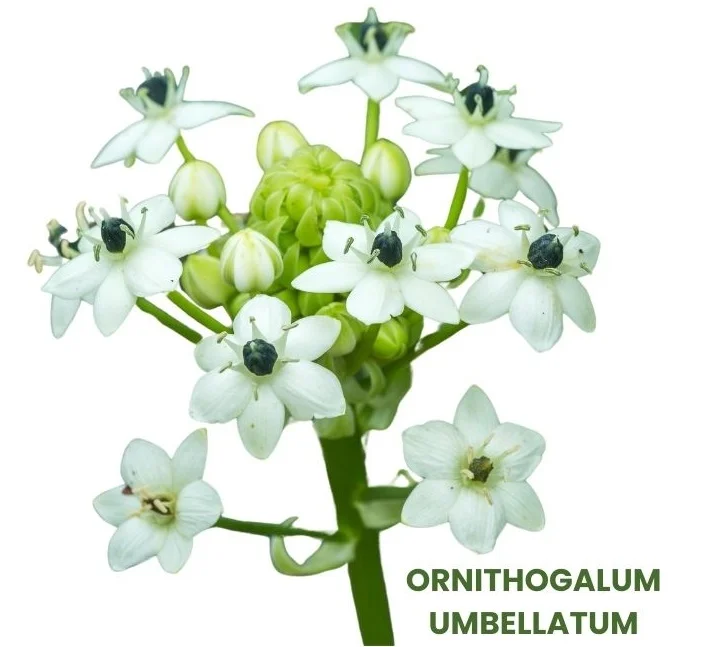Ornithogalum umbellatum, commonly known as Star of Bethlehem, is a homeopathic remedy primarily used for chronic gastric conditions and abdominal indurations, which may include ulceration or even cancer of the stomach or intestinal tract.
The remedy acts specifically on the pylorus (the opening between the stomach and the duodenum), causing painful contractions and distention in the duodenal region.
It is effective in treating severe digestive disorders, including gastric ulcers, vomiting of blood, and severe bloating.

Table of Contents
ToggleSOURCE INFORMATION
Scientific Classification
- Kingdom: Plantae
- Order: Asparagales
- Family: Asparagaceae
- Genus: Ornithogalum
- Species: Ornithogalum umbellatum
Origin
- Ornithogalum umbellatum is a perennial plant native to Europe and the Mediterranean region.
- It is commonly known as Star of Bethlehem due to its star-shaped white flowers.
- Traditionally, the plant has been used in herbal medicine for digestive and emotional disorders, and it became part of the homeopathic Materia Medica for its profound action on the stomach and digestive system.
DRUG PATHOGENESIS
- The main action of Ornithogalum umbellatum is centered on the pylorus, the area of the stomach that connects to the duodenum.
- This remedy causes painful contractions, leading to distention and gas buildup in the upper abdomen.
- It is particularly effective in addressing gastric ulcerations, vomiting of blood-streaked or coffee-ground-like material (indicative of gastrointestinal bleeding), and severe gastritis.
- Patients may experience significant loss of appetite, retching, and weight loss due to ongoing digestive issues.
KEY CHARACTERISTICS
Gastric and Abdominal Indurations
- This remedy is considered in cases of chronic gastric conditions, including cancerous growths in the stomach or cecum.
- Patients typically experience agonizing pain in the stomach, which often radiates to the chest.
Pyloric Issues
- The pylorus is the center of action for this remedy, where it causes contractions, leading to distention and bloating in the duodenum.
- Pain worsens when food passes through the pyloric outlet.
Vomiting and Retching
- Vomiting is characterized by the appearance of coffee-ground-like material, a sign of gastric bleeding.
- Patients may experience retching with phlegmy mucus and severe nausea.
Depression and Prostration
- There is a marked sense of depression and prostration, with patients feeling too weak to carry on with normal activities.
- The feeling of sickness often keeps them awake at night, adding to their exhaustion.
DETAILED ORGAN SYMPTOMS
STOMACH AND DIGESTIVE SYSTEM
- Tongue coated: A sign of underlying digestive distress, often seen in chronic conditions.
- Agonizing pain: Radiating from the pylorus to the chest and stomach, causing severe discomfort, especially after eating.
- Distention: The stomach becomes bloated and distended, with frequent belching of offensive gas.
- Gastric ulceration: The remedy is indicated for gastric ulcers, even in severe cases where bleeding occurs.
- Vomiting: The patient may vomit coffee-ground material, indicating the presence of blood in the stomach.
- Loss of appetite and weight loss: Due to chronic gastric issues, the patient often suffers from anorexia and weight loss.
- Sinking pain across the epigastrium: A heavy, sinking feeling in the upper abdominal region, further contributing to the patient’s discomfort.
GENERAL SYMPTOMS
- Depression of spirits: The patient feels mentally and emotionally low, often losing hope due to prolonged illness.
- Prostration: Complete physical exhaustion, making it difficult for the patient to carry out daily activities.
- Restlessness at night: The feeling of sickness and discomfort keeps the patient awake, leading to sleepless nights and further weakness.
MODALITIES
Worse
- Symptoms worsen when food passes the pyloric outlet, causing severe pain and discomfort in the stomach.
- The distention and bloating are aggravated after eating.
Amelioration
- Relief may come with rest and avoiding large meals, though the patient’s overall condition may be difficult to manage without specific intervention.
WHAT ARE MODALITIES IN HOMOEOPATHY?
RELATIONSHIP WITH OTHER DRUGS
Compare with
- Argentum nitricum: For severe gastritis and ulceration with anxiety.
- Carcinosinum: In cases of gastric cancer or chronic digestive disturbances with ulceration.
- Phosphorus: Useful for vomiting of blood, gastric ulcers, and burning pains in the stomach.
DOSE
- The recommended dosage is typically a single dose of the mother tincture, after which the practitioner awaits its action.
- Repeated dosing may be unnecessary unless symptoms persist.
Frequently Asked Questions (FAQs)
What is Ornithogalum umbellatum used for in homeopathy?
- Ornithogalum umbellatum is primarily used for treating chronic gastric issues, such as gastric ulcers, cancer of the stomach, or indurations (hardened tissue) in the abdominal region.
- It is also used to relieve severe bloating, vomiting, and gastritis.
How does Ornithogalum umbellatum affect the stomach?
- The remedy acts on the pylorus, causing painful contractions and distention of the stomach and duodenum. It helps manage symptoms like gastric pain, vomiting, and ulceration.
Can Ornithogalum umbellatum be used for ulcers?
- Yes, it is highly effective for gastric ulcers, especially when accompanied by symptoms like vomiting of coffee-ground material (a sign of bleeding) and retching.
What potency is recommended for Ornithogalum umbellatum?
- A single dose of the mother tincture is often sufficient, with the practitioner awaiting its action before repeating the dose if necessary.
Can Ornithogalum umbellatum help with depression related to illness?
- Yes, the remedy addresses both physical prostration and mental depression, often seen in patients suffering from chronic digestive disorders.
Glossary of Difficult Words
- Pylorus: The opening between the stomach and the duodenum (the first part of the small intestine).
- Induration: The hardening of tissue, often seen in chronic diseases or cancerous growths.
- Epigastrium: The upper central region of the abdomen, located just below the ribcage.
- Gastritis: Inflammation of the stomach lining.
- Anorexia: Loss of appetite, often leading to weight loss.
- Prostration: Extreme physical weakness or exhaustion.
- Retching: The act of making vomiting motions, often without producing vomit.
- Phlegmy: Thick mucus-like substance that is often expelled during vomiting or coughing.
- Coffee-ground vomit: Vomit that resembles coffee grounds, indicating the presence of partially digested blood.
